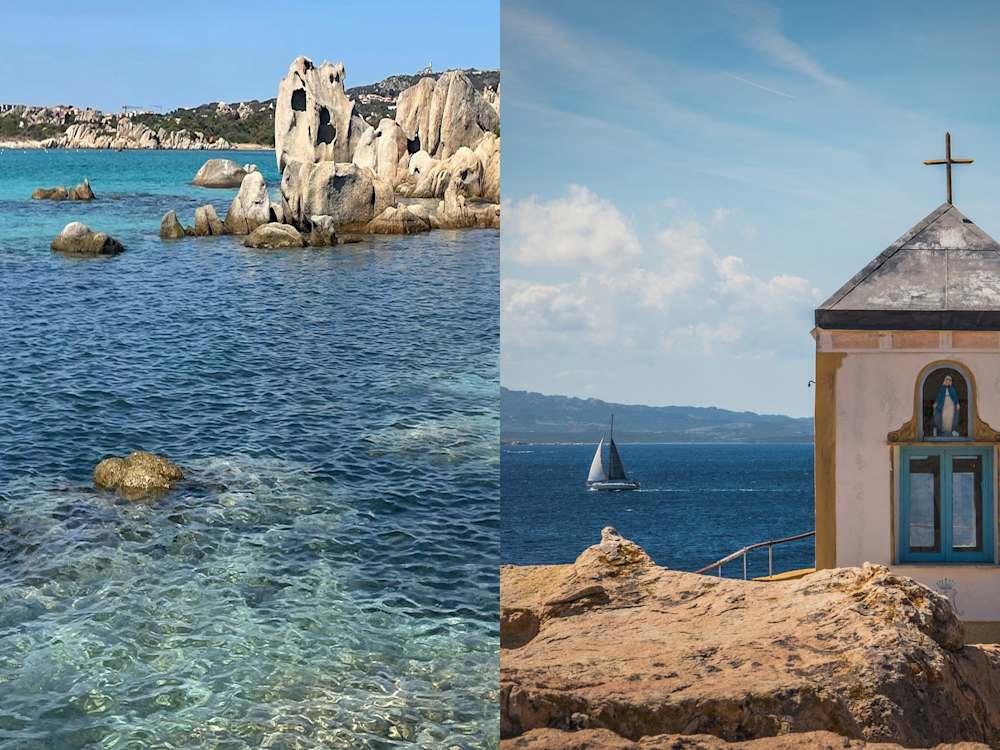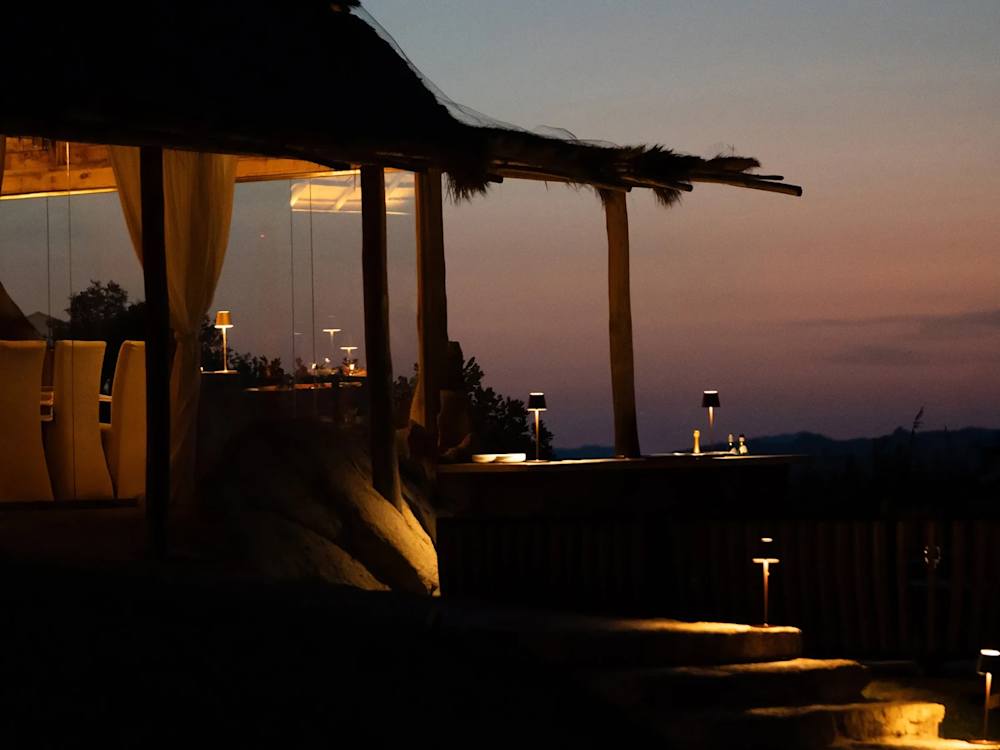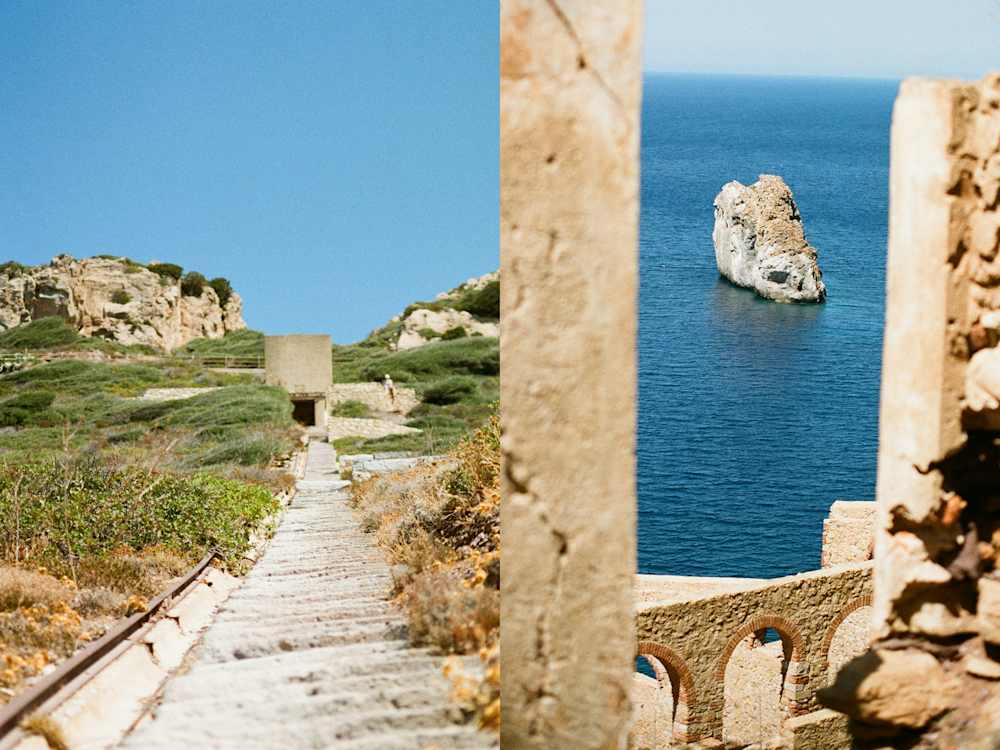One look at a vessel-tracker app in high summer will have you wondering if all of the super-yachts in the world are moored off the north-eastern coast of Sardinia. Porto Cervo — built by Prince Karim Aga Khan in the early Sixties, and a holiday playground for the Ultra-High-Net-Worths of the world ever since — is one of the most expensive ports on the planet, with moorings there costing thousands of Euros a night. If you can’t secure a berth in Porto Cervo, fear not — there are equally fabulous places to drop anchor up and down the Costa Smeralda and beyond, in Golfo Aranci, Cala di Volpe and Baja Sardinia.
In lieu of being in possession of a personal catamaran, I recently explored the region by car, swapping high seas for hairpin bends and rural roads, discovering Sardinia’s glamorous north-east from a different vantage point. It’s essential to locate a vessel for a day-trip to the Maddalena archipelago, but otherwise you can take in coast and country by car; from the ancient mountains of Gallura all the way down to the glitz that awaits at sea level.
WHERE TO STAY

Gallicantu Stazzo Retreat
Many of the best hotels in Sardinia are centred around the island’s north-east, for obvious reasons — this well-heeled holiday playground has been attracting affluent guests every summer for six decades and counting. In the province of Sassari and just a short drive away from Porto Cervo, my first stop was Gallicantu Stazzo Retreat, which is a world away from the glitz and glamour of the shoreline. My first impression: this sylvan setting belongs to a staging of A Midsummer Night’s Dream; I half-expected a sprite or a talking donkey to emerge from behind the giant ancient cork tree.
Former professional golfer and owner Marco Berio has traded fairways for the ancient Gallura countryside to create this nine-room hotel in a clearing in the forest, from which Corsica is visible behind the haze in the distance. Only the original farmhouse remains, yet everything else fits harmoniously into its rustic backdrop — it’s almost impossible to believe that the authentic-looking stone outbuildings are recent additions. There’s a seamless mix of old and new, with rustic sage-green shutters alongside glossy glass sliding doors.
Just down the road, Cascioni Eco Retreat is a masterclass in the art of the agriturismo, with its vast acreage of olive groves put to good use — activities on offer to guests include kayaking past herons, turtles and wild boars from the lake to the sea; birdwatching from the purpose-built wooden tower; cookery classes in an outbuilding and treatments in a breezy pod hidden away in the grounds. This is the Costa Smeralda hotel for you if you seek space; my room was one of the furthest away from reception, with a path leading through its garden to a private pool and a terrace for siestas in the shade. There’s a restaurant at the hotel, as well as two owned by the same family a short drive away: one at the farm where they produce honey, wine and olive oil, and the other a beach club on the coast.
One of the most famous hotels in Sardinia, Petra Segreta Resort & Spa started as a restaurant with a handful of rooms, when its doctor owner decided to indulge his love of cooking. Over the past two decades, it has become one of the island’s most luxurious places to stay, now with an osteria and a Michelin-starred restaurant. Food is still at the fore, with fine-dining breakfasts of small plates and several courses. It’s a short drive out of scenic San Pantaleo, and in the middle of the countryside, but with the Maddalena archipelago and the shores of Cannigione in the distance. The estate is surrounded by the giant granite boulders so commonly seen in this part of Sardinia, some more strangely shaped than others — various wind-and-rain-hewn formations in the region resemble elephants, bears and oversize mushrooms. My room had a private pool on its outdoor deck (11 of the 27 here do), which helped me to appreciate geology more than ever before.
THE BEST BEACHES IN COSTA SMERALDA
Just south of Olbia and before you hit the Costa Smeralda proper, San Teodoro is a popular beach spot, evidenced by the hundreds of people who were stretched out on the sand when I called by en route north on a blazing mid-July day. There’s a reason everyone flocks here: the beach is as white as icing sugar and the water the clearest, palest cyan. But along this dazzling coastline, you’re never far from a photogenic shore.
The Aga Khan, who put this part of Sardinia on the map, favoured Spiaggia del Principe (its regal name is a nod to the man himself). There are lots of hidden coves to discover, but if you want a slick operation (as opposed to BYO cool boxes, windbreakers and self-wedged parasols), head to Spiaggia La Celvia for its brilliant bars and restaurants. Other options for sun, sea and sand along the Costa Smeralda include family-friendly Spiaggia di Marinella near Porto Rotondo and the lengthy Romazzino and Liscia Ruja.
WHAT TO DO

La Maddalena
Every single person you meet in Sardinia, especially in the north, will tell you to get to La Maddalena archipelago, so it’s probably best to take heed. Most hotels can arrange boat charters, or you can set sail from Cannigione or Palau — another option is to take the ferry to the main island Maddelena and find a willing skipper there. Only one of the seven bigger landmasses, Maddalena itself, is inhabited; the rest (along with some smaller islets) can be explored as your vessel drops anchor for you to jump in and explore the coves. The island of Budelli is home to the famous Cala di Roto, a beach with pink sand. It’s said that some of the granite used in the Statue of Liberty was quarried in La Maddalena islands.
For the best shopping potential in the Costa Smeralda, locate the village of San Panteleo, not least for its market, held on the church square every Thursday morning, and its many boutiques selling trinkets, clothing and homewares (Ismeralda is a must for billowy, floaty dresses). If it’s designer threads you need, the terracotta-Disneyland boutiques of Porto Cervo await.
WHERE TO EAT

Il Fuoco Sacro
As with any self-respecting, ultra-glam resort town, the big restaurant brands bring even more jet-set cachet to Porto Cervo: Zuma and Novikov among them, with Matsuhisa and Beefbar outposts a little out of the centre. Petra Segreta is home to the Michelin-starred Il Fuoco Sacro — the name means ‘the sacred fire’, and you’ll be grateful for these flames after your meal.
For authentic Italian cooking (and red-and-white checked tablecloths), Il Pomodoro on Via Porto Vecchio in Porto Cervo has been recreating traditional recipes since 1976; or head inland to La Colti, the working farm brought to you by the same team as Cascioni Eco Retreat, for suckling pig roasted on herby embers, enjoyed under the welcome shade of an ancient carob tree. On La Maddelena, La Scogliera in Porto Massimo celebrates the bounty of the waters all around it, served up with a view of Caprera island.
THE MOST SCENE-Y BEACH CLUBS
This part of Sardinia is nothing if not showy, and you can see and be seen at Phi, one of the most sought-after beach clubs on the island, set on a rocky promontory at a northern tip of Baja Sardinia. Nearby is Mykonos export Nammos, and, naturally, the shores of Costa Smeralda are also home to a Nikki Beach outpost — this one’s in Cala Petra Ruja.
WELLNESS IN COSTA SMERALDA
Those turquoise waters and immaculate sands will be tonic enough, but if you need to take the wellness up a notch, head to Seven Pines Resort in Baja Sardinia and book in at its Pure Seven Spa. Facilities to further ease your stresses away include a steam bath, sauna and Kneipp therapy, plus ‘emotive’ and ice showers to make Wim Hof proud. You can also practise yoga on a wooden jetty, road-test orange and rosemary scrubs and body wraps, and have an Espa facial to give you an A-list glow, ready to hit Porto Cervo.
GETTING THERE
Olbia, the biggest city in the north-east and the gateway to the Costa Smeralda, has its own airport (with plenty of flights in high season; far fewer in the winter), but flights also land in capital Cagliari in the south and Alghero in the north-west in case you fancy a road trip. You’ll also be able to arrive in Olbia by ferry from the Italian mainland, including from Civitavecchia near Rome, but don’t expect the crossing to be swift (the average journey time is seven hours).
GOOD TO KNOW

There’s no hiding from the sheer glamour of the Costa Smeralda, but it doesn’t have to be the sole focus of your trip. This is an island with a rugged, wild spirit, away from the glitz — make sure you see that side too. Sardinia is ancient, with archaeological sites that date back as far as 1900BC. The island has its own language (the neo-Latin Sardinian, which has been deemed endangered by Unesco) and several dialects are spoken throughout. In the north-west near Alghero, the islanders converse in their own version of Catalan, a hangover from the Spanish rule of the 16th and 17th centuries.
Sardinia is an official Blue Zone, promising effortless longevity to its population that will make the biohacking tech bros weep — no red light, grounding routines or offspring-blood transfusions needed; just olive oil, fresh fish and tomatoes, and an active lifestyle into old age. So make like a Sardinian pensioner and take it slow during your stay.
See more of our Sardinia hotels, or head on over to the Italian mainland



